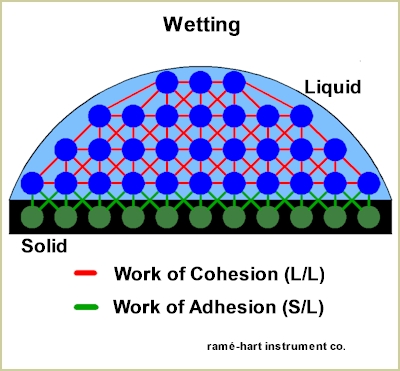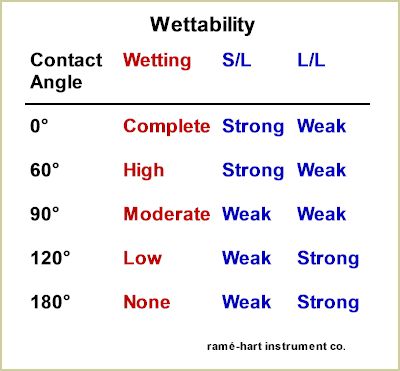|
February 2009 |
||
| Wetting, Adhesion, and Cohesion | ||
|
Wetting occurs when a liquid maintains contact with a solid surface. The degree to which wetting occurs (i.e., wettability) is determined by the cohesive forces of the liquid molecules among themselves and the adhesive forces that result from the molecular interactions between the liquid and the solid as illustrated in the diagram below. (In real life, the molecules are not so neatly organized.) Often wettability is measured by contact angle.
As the contact angle decreases, wetting increases. Conversely as the contact angle approaches 180°, wetting decreases. Wettability can be explained by the relative strength of the cohesive (L/L) and adhesive (S/L) forces as shown below. Strong adhesion with weak cohesion produces very low contact angles with nearly complete wetting. As the solid/liquid interactions weaken and the liquid/liquid interactions strengthen, wetting diminishes and contact angle increases.
Thus we define the Work of Adhesion as the interactive force between the liquid and solid phases and we use the Young-Dupree equation as follows:
The Work of Cohesion is defined as the force required to separate the liquid into separate parts and we use this formula:
Thus we have determined that the contact angle is somewhat inversely proportional to wettability. When the adhesive forces are weak and the cohesive forces are relatively stronger, high contact angles result indicating a lyophobic condition. When the contact angle exceeds 150° the condition is called superlyophobic (superhydrophobic if the liquid phase is water) and is often referred to as the "Lotus Effect" after the plant whose leaves exhibit extremely low wetting. When the contact angle exceeds 170° the condition is called ultralyophobic. On the flip side, very low cohesive forces relative to high adhesive forces produce lyophilic conditions with low contact angles and very high wettability. The study of wettability is most easily accomplished when the solid phase is perfectly flat, smooth, chemically homogenous, and completely clean. In such ideal conditions, the contact angle hysteresis (that is, the difference between the advancing and receding contact angles) would be close to zero. (See our February 2008 Newsletter for a detailed discussion of advancing and receding.) In the real world, however, most solids are less than ideal and thus will exhibit a contact angle hysteresis. The change between maximum and minimum contact angles in a three-phase system is referred to as dynamic wetting. The contact angle hysteresis is used by researchers to quantify surface heterogeneity (the Wenzel state), surface roughness (the Cassie state), and to a lesser extent, surface deformation, liquid penetration, and surface mobility. Typically we measure dynamic wetting by adding and removing volume to and from a drop without increasing or decreasing the three-phase line while simultaneously measuring the contact angle. This is most easily accomplished with our Automated Dispensing System and is the preferred method when measurements are time-sensitive. Additionally, we can measure advancing and receding contact angles using our Tilting Base option (shown below) with any ramé-hart contact angle goniometer. The latter method is considered superior by many due to the fact that no needle or dispensing tip is disturbing the drop while measurements are taken.
|
||
| What is a Knol? | ||
|
A Knol is a unit of knowledge as defined
by Google's new service (knol.google.com) which allows experts to write
short articles to explain specific tasks or topics. The Google Knol
competes with Wikipedia for a slice of the free information market.
Unlike Wikipedia which is pure collaboration; Knols are written by
individuals or co-authors and readers can comment but cannot directly
edit them. A rating system is included to help readers find the most
helpful article on topics for which many articles may exist. The jury is still out on the Knol. Perhaps it will someday dominate Wikipedia and become as household as Google itself. Or perhaps it will go the way of the Edsel and the Betamax format. Time will tell. In the meantime, we've written our first Knol and invite you to read it. Go to http://tinyurl.com/dzffep to access the article. Please rate it and leave any comments that are pertinent. |
||
|
|
||
|
||




